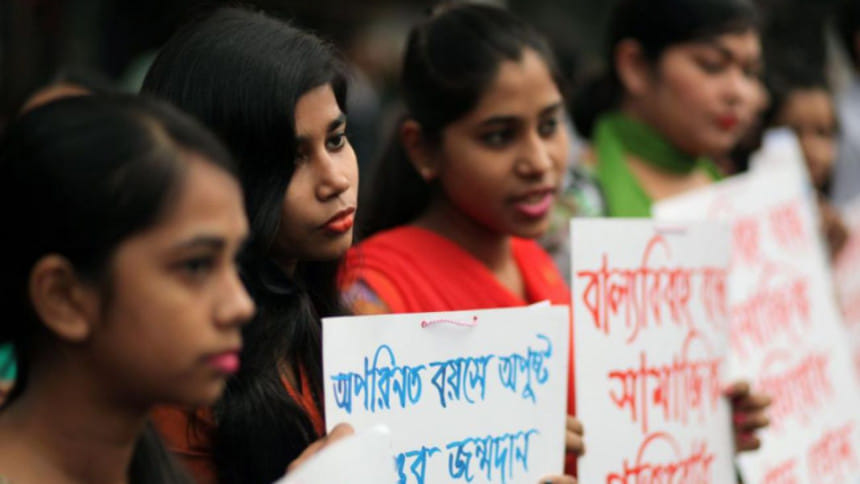Ending child marriage is good economics

Recently, I came across a news report that is quite shocking and concerning. A UNFPA (United Nations Population Fund) study reveals that 59 percent of the marriages that took place in Bangladesh between 2006 and 2017 involved brides below the age of 18. The rate is the highest in South Asia and the fourth highest in the world behind Niger, Central African Republic and Chad. The data also suggests that child marriage is a major obstacle for Bangladesh to achieving the sustainable development goals (SDGs) by 2030. Therefore, understanding the causes and effects of child marriage and how to tackle it can help, not only to end the daily suffering of adolescent girls and the continual violation of their human rights, but can also help achieve multiple development goals.
Child marriage is a complex phenomenon related to various socio-economic factors, and is deeply rooted in existing cultural and religious traditions and poverty. Although Bangladesh has made remarkable progress in reducing poverty, almost 1 in 4 Bangladeshis (24.3 percent of the population) still live in poverty and 12.9 percent of the population in extreme poverty. Poverty plays a huge role in child marriage. According to a Human Rights Watch report, "global data shows that girls from the poorest 20 percent of families are twice as likely to marry before 18 as girls whose families are among the richest 20 percent." Several studies found that in Bangladesh, many poor parents who are unable to feed their children, or pay for their education costs seek a husband for their daughters as a survival strategy. Even though education (primary, secondary) is free, many families are unable to afford fees for exams, uniforms, stationery and other associated costs. And as a consequence, their girls lack access to education and end up in early marriages.
Unicef's latest report shows environmental disasters linked to climate change are threatening the lives of over 19 million children in Bangladesh—including prompting many families to push their daughters into early marriages. The other factors driving child marriage in Bangladesh includes cultural and religious traditions, lack of access to education, social pressure, harassment, dowry and insecurity. Our society still thinks girls are weak and incapable to work and earn an income and often consider them an economic burden. Many girls themselves internalise the belief that they are simply a burden to their families and therefore want to get married young to help relieve their families.
Then there is the fear of harassment which often leads to abuse and rape. According to police reports, last year there were 16,253 incidents of violence against women and children. In our society, if a girl has been raped or sexually abused in any way, it decreases her chances of getting married in the future. So many parents simply take their daughters out of school to protect them from abuse and ensure their viability as brides in the future. Demand for dowry also encourages child marriage because younger brides typically require smaller dowries. And failure to meet the demand of dowry often results in violence against the bride, after marriage.
Experts opine that the economic cost of child marriage is high and clearly contributes to poverty and has a large negative effect on economic growth. The process of economic development is complex and multidimensional, with vulnerabilities in some areas affecting other parts, and child marriage is a perfect example of this. Different studies show that the economic impacts and associated costs of child marriage are large and far-reaching, since it affects girls' health, nutrition, labour force participation, and their children and communities as well.
When forced to marry at a young age, many girls drop out of school without completing their education and thus lose the opportunity to develop the skills and knowledge necessary for formal employment. Lack of education disempowers women and they remain dependent on men and others throughout their life. Earning money becomes the sole responsibility of the men of the family and as a consequence, the nation remains deprived of the financial contributions of women which perpetuates the cycle of poverty and thereby curtails overall economic growth. Since mothers with little or no education are unaware of the benefits of education, they are less likely to keep their own children in school. The discontinuation of education that results from child marriage puts a huge dent to the political and socio-economic development of the country.
Child brides, even if they are not physically or emotionally ready, are often expected to bear children soon after marriage—which not only exposes a young girl to profound health risks from early pregnancy, but is considered one of the leading causes of higher maternal and infant mortality. According to UNICEF estimates, a third of the girls aged between 15 and 19 are mothers or are pregnant.
Teenage mothers are twice as likely to die during childbirth and babies born to mothers under 14 are 50 percent more likely to die than those born to mothers aged over 20. Young brides not only bear children earlier, but have more children over their lifetime than women who marry after the age of 18. According to a research report titled, "The Economic Impacts of Child Marriage", conducted jointly by The World Bank and The International Center for Research on Women (ICRW), early marriages contribute to high population growth, thereby threatening access of households to the often scarce resources they need to thrive on—putting pressure on government budgets to deliver quality services.
To prevent child marriage, we need to take some effective social and political measures.
As per Bangladesh's law, the minimum age for marriage for men and women are 21 and 18 respectively. However, a special provision in the Child Marriage Restraint Act, 2017 allows parents to marry off their children earlier by obtaining a court order.
Many human rights activists claim that such a provision to the law would not only encourage child marriage, but technically make child marriages legal. In our country, almost 95 percent of child marriages take place in the rural areas, where education is limited.
Lack of education is one of the most influential factors behind gender subjugation and, consequently, women's economic alienation. Education is the key for everyone, especially girls. Different studies show that girls with no education are over three times more likely to be married off before the age of 18 than those with secondary or higher education. Therefore, delaying the age of marriage and investing in girl's future by giving them an opportunity to build skills and knowledge, and by scrapping the special provision in the Child Marriage Restraint Act 2017 can reduce child marriage.
Also, we need to involve families, communities and different social organisations to raise awareness about the harmful consequences of child marriage to change societal attitudes and reduce the acceptance among those who make the decision to marry off minor girls. We need to understand that exclusion of 50 percent of the population (women) from both the workplace and the market remains the greatest barrier to accelerating economic development.
For comprehensive economic development and poverty alleviation, economic participation of women and their integration into the national workforce is a must. And therefore, empowering their participation in the workforce is essential not only for reducing poverty and economic growth, but also for achieving social justice. Ending child marriage and ensuring that girls go to school is where it can all begin.
Abu Afsarul Haider studied economics and business administration at the Illinois State University, USA, and is currently involved in international trade in Dhaka.
Email: [email protected]

 For all latest news, follow The Daily Star's Google News channel.
For all latest news, follow The Daily Star's Google News channel. 


Comments